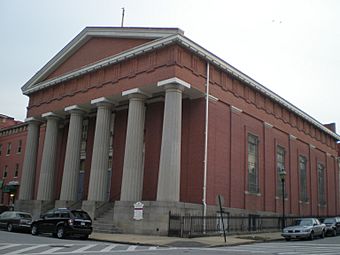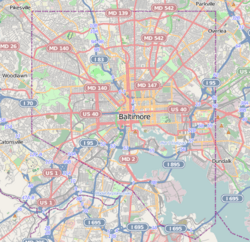St. Peter the Apostle Church facts for kids
Quick facts for kids |
|
|
St. Peter the Apostle Church and Buildings
|
|

St. Peter the Apostle Church, Baltimore, MD
|
|
| Location | 11 and 13 S. Poppleton St. and 848 Hollins St., Baltimore, Maryland |
|---|---|
| Area | 0.5 acres (0.20 ha) |
| Built | 1843 |
| Architect | Long, Robert Cary, Jr.; Et al. |
| Architectural style | Greek Revival |
| NRHP reference No. | 76002184 |
| Added to NRHP | October 14, 1976 |
St. Peter the Apostle Church was an important Roman Catholic church in Baltimore, Maryland. It was built in a part of the city often called "West Baltimore." People often called it "The Mother Church of West Baltimore" because it was so significant to the community.
Contents
Building a New Church for a Growing Community
The church was built in 1842. It was meant to serve the many Irish people who had moved to Baltimore. These immigrants came to the city to work for the B&O Railroad.
Design and Style
Robert Cary Long, Jr. designed the church. He was a famous local architect. He designed the church in the Greek Revival style. This means it looked like ancient Greek temples. It had large granite pillars at the front.
The inside of the church had a big, open space called a nave with wooden pews (benches). Behind the altar, there was a special area called an apse. It had white columns and a beautiful white marble tabernacle. This tabernacle held statues of angels and the holy family. A large statue of Saint Peter was on top. Above the tabernacle, it said, "Tu Es Petrus." This Latin phrase means "You are Peter," from the Bible verse, "You are Peter, and on this rock I will build my Church."
The church also had a historic organ built by Henry Niemann. This organ was moved to storage when the building was sold in 2012.
From Old to New: The Church's Name Lives On
The name "St. Peter the Apostle Church" was moved to this new building. This happened after the original St. Peter's Roman Catholic Church was closed and torn down in 1841.
The first "Roman Catholic Congregation of Baltimore Town" started in 1770. It was founded by new immigrants called Acadians. They were French Canadians who had been forced to leave their home in Acadia (now Nova Scotia). They settled in Baltimore along the Patapsco River. Later, more Irish settlers joined them.
The original St. Peter's building was very important. From 1791 to 1821, it was the first "Pro-Cathedral" (a church used as a cathedral before a main one is built) in the United States. Father John Carroll became the first bishop for the United States in 1789. His main church was old St. Peter's.
In 1821, the bishop's main church moved to the new Cathedral. This new cathedral was designed by Benjamin Henry Latrobe. Even after this, Old St. Peter's continued to serve the downtown community for another 20 years. As the city grew, people moved to new residential areas. So, in the early 1840s, the Archdiocese decided to build a new church with the old name.
A New Home in Union Square
The new St. Peter the Apostle Church was built in a neighborhood that later became known as "Union Square". This area had many parks and squares. The church building was part of a group of buildings. This group included the church, a rectory (where priests live), a convent (where nuns live), and a school.
Important Leaders and Growth
The Reverend Edward McColgan founded the new church. He served there for over 30 years. The first stone for the new church was laid on May 23, 1843. Many important church leaders helped dedicate the church on September 22, 1844.
Father McColgan helped the Sisters of Mercy come to the church in 1855. They taught at St. Peter School, which was a school for girls next to the church. The Sisters also helped people in need. They opened the "House of Mercy for distressed women." Father McColgan also started the first Catholic group in the city to encourage people to avoid alcohol in 1849.
The church grew so much that by 1865, a second church was started. St. Peter the Apostle Church itself was made bigger twice in its first 40 years. In 1868, it was fully renovated. They added more pews, extended the building, and installed beautiful Munich, Germany stained glass windows. The church was rededicated in 1869. It was now 150 feet long and 73 feet wide.
Recognized for History and Community Work
In 1967, the church was renovated again. This renovation caught the attention of the Baltimore City Commission on Historical and Architectural Preservation. Because of its historical importance, the church was added to the National Register of Historic Places on October 14, 1976.
Throughout its history, St. Peter the Apostle Church helped people in need. It also worked to improve the community. In 1965, the pastor, Thomas J. Donellan, started the Southwest Baltimore Citizens Planning Council. This group worked with other churches to help the Hollins Park neighborhood. The former convent building even became a Christian Life Center, offering fun activities and programs.
The Church Closes Its Doors
In later years, fewer people attended the church, and there were fewer priests. Because of this, the church held fewer services. The last regular Mass at St. Peter's was on January 26, 2008. After that, the church was only used for special events like weddings and funerals. The churches of St. Martin, St. Peter, and St. Jerome later joined together to form a new parish called the Transfiguration Catholic Community.
St. Peter's Church officially closed after 165 years of service. In 2012, the church was sold to the Carter Memorial Church of God in Christ. Many of the church's important items, like statues and relics, were moved to other churches in the Archdiocese. The large pipe organ was put into storage, waiting to find a new home in another church.











